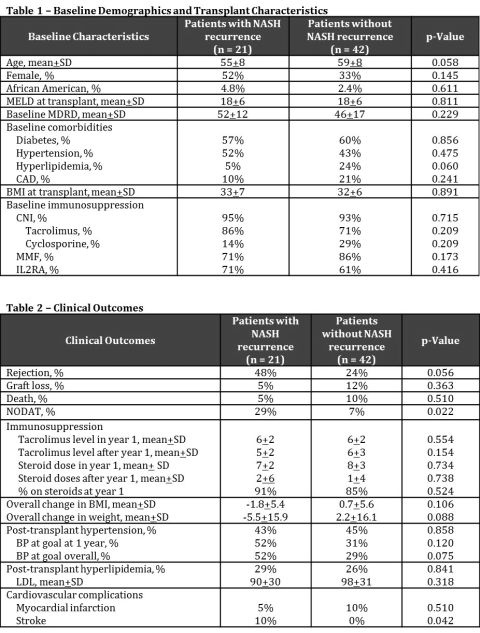NASH Recurrence: Focus on Preventing New Onset Diabetes?
Pharmacy, MUSC, Charleston, SC
Transplant, MUSC, Charleston, SC
Meeting: 2013 American Transplant Congress
Abstract number: B1080
Background: The aim of this study was to evaluate the risk factors and associated outcomes with NASH recurrence following liver transplant.
Methods: Single center retrospective longitudinal cohort study of 704 liver patients transplanted at an academic medical center from 2000-2011. Exclusions were pediatrics (n=47), patients with insufficient records (n=45), patients transplanted for indications other than NASH (n=542), and those that died within 30 days of transplant (n=7).
Results: Of the 704 patients, 63 patients had NASH cirrhosis and were included in the analysis (21 with recurrent NASH and 42 with no recurrence). Baseline demographics (Table 1) were similar between groups. Rejection (48% vs 24%, p=0.056) and NODAT (29% vs 7%, p=0.022) were higher in the recurrent group; there was no difference in graft loss or death between groups. Cardiovascular disease (CVD) burden (HTN, dyslipidemia) and events (AMI, stroke) were also similar between groups.
Conclusion: These results suggest that rejection and NODAT are the most important factors associated with NASH recurrence. CVD burden and events are common in both groups, and did not appear to influence disease recurrence.

To cite this abstract in AMA style:
Jordan C, Pilch N, Taber D, Meadows H, Fleming J, Mardis A, Morbitzer K, Makowski C, McGillicuddy J, Bratton C, Lin A, Baliga P, Chavin K. NASH Recurrence: Focus on Preventing New Onset Diabetes? [abstract]. Am J Transplant. 2013; 13 (suppl 5). https://atcmeetingabstracts.com/abstract/nash-recurrence-focus-on-preventing-new-onset-diabetes/. Accessed December 9, 2025.« Back to 2013 American Transplant Congress
